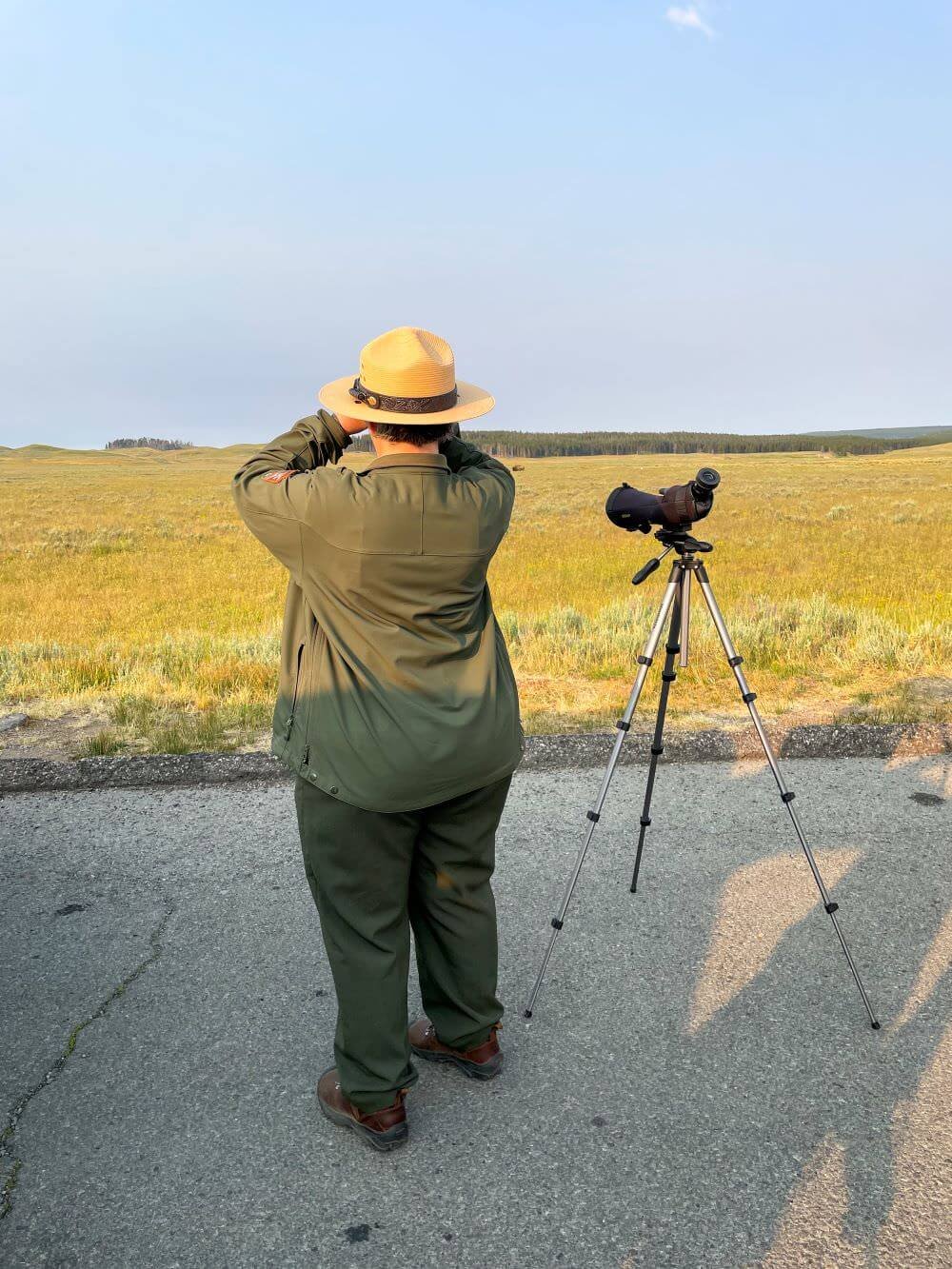12 Best Places for Wildlife Viewing in Yellowstone
Yellowstone National Park is a wildlife enthusiast's dream, offering some of the best opportunities to see animals in their natural habitat.
With its vast landscapes ranging from valleys to mountain peaks, rivers, and dense forests, the park is home to an incredible diversity of species. Visitors can spot bison, bears, wolves, elk, bald eagles, and more as animals roam freely throughout the park.
Whether you're hoping to spot a bear in the wild, are an avid birdwatcher, or are looking to catch a glimpse of Yellowstone's famous wolves, this guide highlights the best places to see wildlife in Yellowstone National Park!
Table of Contents Show
1. Lamar Valley
Lamar Valley is arguably the best spot in Yellowstone for wildlife viewing. The Northern Range as a whole—from Yellowstone’s North Entrance to the Northeast Entrance—is where you want to be for incredible wildlife opportunities in the park.
Here, you can see bison, wolves, bears, bald eagles, coyotes, pronghorn, and more!
2. Hayden Valley
Hayden Valley is a beautiful valley near the Grand Canyon of the Yellowstone that’s perfect for viewing large herds of bison and other wildlife, including wolves, grizzly bears, and coyotes. The early mornings and late evenings in Hayden Valley are prime for wildlife activity.
3. Yellowstone’s North Entrance
Near the park’s North Entrance at Gardiner, MT, you can often spot elk and pronghorn antelope. Drive from Gardiner to Mammoth Hot Springs, keeping your eyes peeled along the way.
Pronghorn antelope near Yellowstone's North Entrance.
4. Mammoth Hot Springs
The open fields around Mammoth Hot Springs are often filled with bison calves in the spring and elk in the fall. These herds are frequently seen grazing near (or even on!) the hot springs, especially elk, during their fall rut.
5. Blacktail Plateau
This less-traveled area is a good place to look for wolves, red foxes, and black bears. The plateau’s relative quietness often draws more elusive animals.
6. Tower Fall
The forested area around Tower Fall is a great spot to see black bears and, occasionally, moose. This is an especially incredible place for bear and wildlife viewing from mid-May through June.
7. Slough Creek
Located near Lamar Valley, Slough Creek is a great spot to look for wolves. There’s a nearby den, so wolves can be frequently observed hunting and traveling across the landscape.
8. Northeast Entrance
Close to Yellowstone’s northeast entrance, the rugged mountains provide a haven for mountain goats and bighorn sheep. Keep an eye on the cliffs to catch sight of them. Drive past Lamar Valley toward Yellowstone’s Northeast Entrance and use binoculars or a spotting scope for a closer look.
9. Roadside Meadows
Throughout Yellowstone, pay extra attention to roadside meadows, which offer a chance to see grizzly bears grazing or searching for food. These open fields—particularly along Yellowstone’s Lower Loop—often attract bears during late spring, summer, and early fall months.
Grizzly and cub in a meadow right off the road on the west side of Yellowstone's Lower Loop.
10. Tops of Dead Trees
Look for bald eagles and hawks perched on the tops of dead trees along rivers or open areas. They offer great viewing opportunities as these birds survey their surroundings for prey. Lamar Valley, Dunraven Pass, and the drive from Fishing Bridge to Yellowstone’s East Entrance are great spots to look for bald eagles and hawks.
Bald eagle perched on a tree in Lamar Valley.
11. Dunraven Pass & Mount Washburn
This high-altitude pass is ideal for spotting birds, especially during summer. Visitors often see hawks, eagles, and even falcons soaring over the cliffs. Nearby, Mount Washburn may also offer spectacular views of bears and bighorn sheep grazing along its slopes. When driving from Tower Fall to Canyon Village, grab a spotting scope or binoculars and enjoy the various roadside overlooks.
12. East Entrance Road
The stretch of road leading into Yellowstone from the east is known for frequent grizzly bear sightings. Drive from Fishing Bridge to Yellowstone’s East Entrance, paying extra attention to meadows near Yellowstone Lake… and look for other wildlife watchers to signal something’s nearby!
Yellowstone Wildlife Map
These are great places to look for wildlife in Yellowstone but remember… wildlife can be anywhere, anytime. Keep your eyes peeled while driving through and exploring Yellowstone year-round, as you never know what you’ll spot or where an animal will be!
Maximize Your Chances: 7 Wildlife Viewing Tips for Yellowstone
Here are some tips for the best wildlife-watching experiences in Yellowstone National Park.
Get up early: Many animals are most active at dawn and dusk, so aim to be up and on the road before sunrise for the best opportunities.
Stay out late: Similar to early mornings, evenings are prime times for animal activity. (Think: dawn and dusk for wildlife viewing.) Plan to stay in the park until after sunset.
Use binoculars or a spotting scope: Many animals are far from the road, so having good optics will help you see more and get a closer view without disturbing them or putting yourself in a dangerous situation. Spotting scopes are especially helpful for wolf-watching. A good zoom lens is a must for wildlife photography.
Ask rangers about recent sightings: Park rangers are a wealth of knowledge and can guide you to areas where animals have recently been seen. When you arrive in the park, ask park rangers about recent sightings of bears, wolves, or whichever animal you’re most hoping to see.
Be patient & Drive slowly: Wildlife spotting requires time and quiet observation. Be patient and return frequently to spots where wildlife was recently sighted. Animals also often cross or walk alongside the roads, so drive slowly to give yourself time to spot them and react.
Watch for animal behavior: Signs like circling birds may indicate a recent kill by predators, and herds of bison can sometimes lead you to where wolves or bears might be nearby.
Stay quiet: Loud noises scare off animals. Keep your distance and speak in hushed tones to avoid startling wildlife.
The best times of day for wildlife watching are generally dawn and dusk, as this is when wildlife is typically most active. If you see cars pulled over or folks out of their cars looking through scopes, there’s probably something nearby.
Park rangers are often stationed in areas with high wildlife sightings. Sometimes, park rangers are managing traffic and other times, rangers have scopes set up for a closer look. In this photo, we were watching a wolf pack in Hayden Valley.
Wildlife Viewing Safety
When watching wildlife in Yellowstone, it's important to prioritize safety—for both you and the animals. While witnessing wildlife like bears, bison, and wolves up close is exciting, it's essential to remember that these are wild animals, unpredictable and powerful. Here are some important things to keep in mind during your trip.
Keep your distance: Always stay at least 100 yards away from bears and wolves and 25 yards from other wildlife. Use binoculars, spotting scopes, or a camera zoom lens for close-up views. This is very important for your safety and theirs. You don’t want to be so close that you disturb or displace an animal or put yourself in danger.
Do not feed the animals: Feeding wildlife is dangerous for both you and the animals. It teaches them to associate humans with food, leading to dangerous encounters that threaten their lives (and yours). Do not feed wildlife or keep food where it’s accessible. Always use bear-proof trashcans when disposing of trash in Yellowstone.
Carry bear spray: Always carry bear spray and know how to use it. This is especially important for hikers. Stay bear-aware, even in areas where they are less commonly seen. And be sure to follow all trail closures and signs.
Travel in groups: Larger groups make more noise and are less likely to surprise animals, reducing the chance of an encounter. Hiking in groups of 4 or more is highly recommended. Meet up with other hikers at trailheads.
Use zoom lenses: For wildlife photography, use a large zoom lens, rent a spotting scope, or use binoculars. Never approach animals to take a picture with your phone or camera.
Stay on marked trails: Wandering off trail can lead to unexpected encounters with wildlife. Stay on designated paths to minimize risks.
Respect signs and closures: Certain areas may be closed for the protection of wildlife or to prevent human-wildlife conflicts. Always adhere to park guidelines and bear management area closures and limitations.
Do not run: If you encounter a large animal like a bear or bison, don’t run. Back away slowly. If wildlife moves toward you or shows any signs of distress (huffing & puffing noises, raised hair, feet stomping, etc.), back away slowly and promptly.
Be cautious when driving: Wildlife frequently crosses the road in Yellowstone, especially at dawn, dusk, and during migration periods. Drive slowly and stay alert. Use roadside pullouts for wildlife watching or photography. (Park entirely to the side of any white lines, and do not block traffic when stopping to view wildlife.) If you get in a “bison jam,” which happens when a bison or herd of bison cross the road in front of you, stop to allow the bison to safely cross the street. Once you’re able to, drive past or around the bison to resume the flow of traffic.
Keep Planning Your Trip to Yellowstone National Park
Plan the ultimate Yellowstone vacation with our All-Seasons Yellowstone Travel Guide! With insider tips, detailed maps, and tailored itineraries for each season, ensure you don’t miss out on the best things to do and see in Yellowstone year-round.
Crafted from personal experience over 9 years and 10 trips (& counting), our All-Seasons Yellowstone Travel Guide is packed with expert advice for experiencing the best—and less-traveled—parts of Yellowstone National Park. Take the overwhelm out of planning a vacation to one of America’s largest national parks and make the most of your visit with our comprehensive, easy-to-use travel guide.
Save this for later
Hover over the image below and click on the red “Save” button that pops up in the upper lefthand corner of the image to save this on Pinterest for later. (If you’re on mobile, you might have to tap the image first to see the red ‘Save’ button.)
Happy Travels!
Related Posts

















